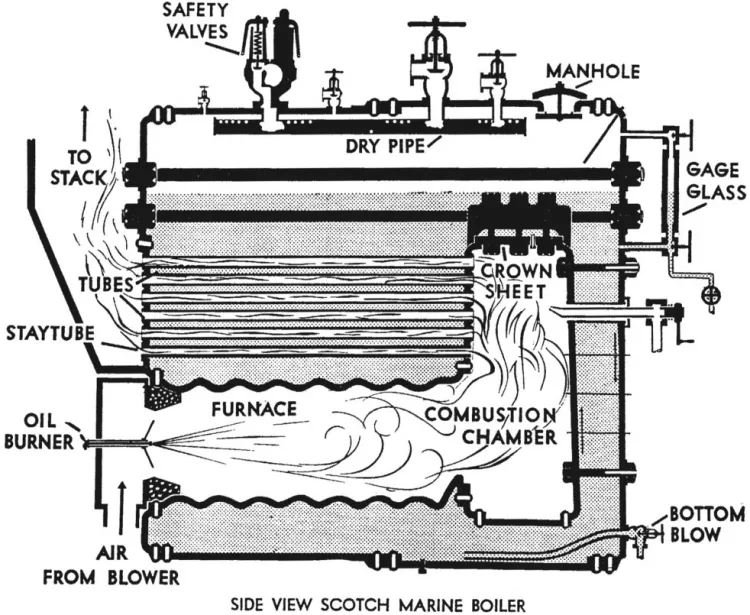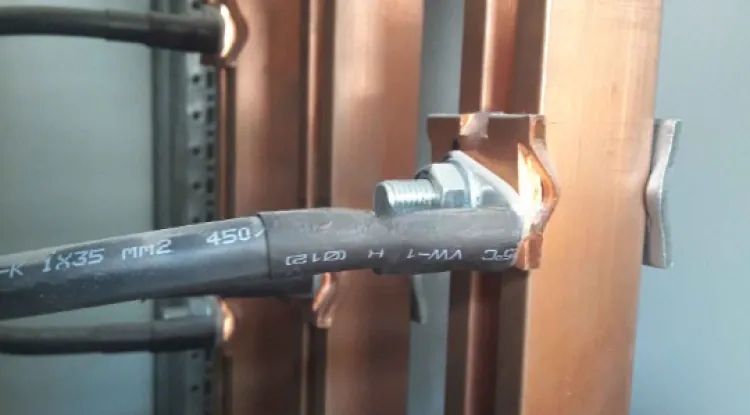Lancashire Boiler - Construction, Working Principle With Advantages and Disadvantages
Construction, Working Principle With Advantages and Disadvantages of a Lancashire Boiler.

Lancashire Boiler is a horizontal type and stationary fire tube boiler. Before we go further, let’s know the person who invented this boiler. Lancashire Boiler was invented in the year 1844, by William Fairbairn. But his patent was for the method of firing the furnaces alternately. Generally, flue gases pass through the fire tube. It is present inside the boiler shell or body and for this reason, it is a fire tube boiler. Lancashire Boiler is an internally fired boiler because the furnace is used to present inside the boiler. This boiler generates low-pressure steam and it is a natural circulation boiler.
Basic Principle of Lancashire Boiler:
This boiler consists of a horizontal cylindrical shell filled with water. It is surrounded by two large fire tubes. Heat exchange is the basic working principle of this boiler. It has a shell and tube-type heat exchanging system. Generally, the flue gases pass through the fire tubes and water flows through the shell. In this way, the heat is transferred from flue gases to the water. It is a low-pressure, internally fired, natural water circulation boiler. That means this boiler uses natural current to flow the water inside the boiler during its operation.
Construction of Lancashire Boiler:
Generally, this boiler consists of a large drum. Its diameter can be up to 4-6m and its length can be up to 9-10m. Normally this drum consists of two fire tubes and its diameter is up to 40 percent of the diameter of the shell. For this boiler, the water drum is placed over the brickworks. Where three spaces are created between the drum and the brick wall. The first one is at the bottom and the second one is at the sides. When the boiler is operational, then the flue gases pass through the fire tubes and side and bottom space.
The great thing about this boiler is that the water level inside the drum is always above the side channels of flue gases. For this reason, more heat can transfer to the water. But the water drum is not filled with water. The boiler water drum is usually half filled with water from the bottom section of the drum and the upper half space is for generated steam. Generally, the Furnace of this boiler is located at one end of the fire tubes which is inside the boiler.
Related:- What is a Fire Tube Boiler?
Then low brick is present at the grates and it makes an obstacle to un-burned fuel and ash to flow in fire tubes during operation. Lancashire Boiler also consists of other necessary mountings and accessories. Those are the economizer, safety valve, super-heater, water gauge, pressure gauge, and some other parts. All are for the better performance of this boiler.
Working of Lancashire Boiler:
For this boiler, hard fuel is burned at the grate. Like a water tube boiler, water is usually pumped into the shell through the economizer. This operation is performed by a water pump. This process increases the temperature of water before further action. Then the fire tube of this boiler is fully immersed into the water.
Generally hard fuel is fired at the grate. This is the first heating process and it produces flue gases. Then generated flue gases pass through the fire tube. This flue gas can pass from one side to another side, inside the boiler fire tube. Boiler fire tubes can transfer 80 to 90 percent of total heat to the water. Then the backward flue gases pass from the bottom passage of this boiler. Through this process, heat from flue gases can transfer another 8 to 10 percent heat to water.
After this process remaining flue gases pass from the side passage of the boiler. It can transfer another 6 to 8 percent of heat to water. Brick walls create those heat transfer channels. Brick walls also work as a heat insulator. There is some damper on each side channel to regulate the airflow. When water absorbs heat then it becomes steam. Steam is stored at the top section of the shell. Then an anti-priming pipe separates the generated steam from the water. Then a steam stop valve received generated steam for various purposes.
Then this steam is transferred to the superheater if it requires superheated steam for any work. There is a blow-off valve is present at the bottom section of this boiler. With this valve, we can clean mud and also drain the water.
Advantages and Disadvantages of Lancashire Boiler:
It’s easy to operate this boiler and it requires less maintenance. Manhole is provided with this boiler and for this reason, it is easy to clean and inspect inside the boiler. It is one of the most reliable boilers. This boiler can generate large amounts of steam and it can easily meet with requirement of steam. This boiler is a natural water circulation boiler. This boiler has a high thermal efficiency of about 80 to 90 percent.
After all those advantages it has some disadvantages. Because this boiler required more space on the floor. It also has a leakage problem. The process of steam generation required more time. This boiler cannot generate high-pressure steam when you need it.
Now if you like this article, then please share it with your friends, and don’t forget to subscribe to our newsletter.
















